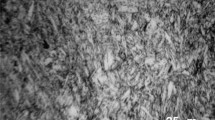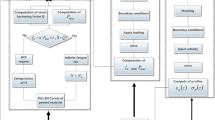Abstract
Shot peening (SP) is a relatively traditional but highly effective mechanical surface treatment that produces a compressive residual stress field in a shot-peened (SPed) surface, which can effectively delay fatigue crack propagation (FCP) and prolong the service life of engineering materials and structures. A multistep analysis method was developed by combining a numerical simulation of the SP process and the LEFM-based (linear elastic fracture mechanics) superposition principle to study FCP behavior in an SP-induced residual stress field. The SP-induced residual stresses were first simulated by a symmetric cell model and then introduced into a finite element model of the CT specimen. The total stress intensity factors and stress ratios with respect to different crack lengths were calculated according to the LEFM-based superposition principle. The influences of external applied load ratios and SP conditions, including one-sided and double-sided SP, on the FCP behavior of the SPed CT specimen were investigated in detail.


















Similar content being viewed by others
References
M. Topic, R.B. Tait, and C. Allen, The Fatigue Behaviour of Metastable (AISI-304) Austenitic Stainless Steel Wires, Int. J. Fatigue, 2007, 29(4), p 656–665
C. Wang, X. Wang, Z. Ding et al., Experimental Investigation and Numerical Prediction of Fatigue Crack Growth of 2024-T4 Aluminum Alloy, Int. J. Fatigue, 2015, 78, p 11–21
Z.M. Wang, Y.F. Jia, X.C. Zhang et al., Effects of Different Mechanical Surface Enhancement Techniques on Surface Integrity and Fatigue Properties of Ti-6Al-4 V: A Review, Crit. Rev. Solid State, 2019, 44(6), p 1–25
Y.X. Chen, J.C. Wang, Y.K. Gao et al., Effect of Shot Peening on Fatigue Performance of Ti2AlNb Intermetallic Alloy, Int. J. Fatigue, 2019, 127, p 53–57
S. Saalfeld, B. Scholtes, and T. Niendorf, On the Influence of Overloads on the Fatigue Performance of Deep Rolled Steel SAE 1045, Int. J. Fatigue, 2019, 126, p 221–230
C. Wang, L. Wang, C.L. Wang et al., Dislocation Density-Based Study of Grain Refinement Induced by Laser Shock Peening, Opt. Laser Technol., 2020, 121, p 105827
Y.F. Al-Obaid, A Rudimentary Analysis of Improving Fatigue Life of Metals by Shot-Peening, J. Appl. Mech., 1990, 57(2), p 307–312
Y.F. Al-Obaid, Shot Peening Mechanics: Experimental and Theoretical Analysis, Mech. Mater., 1995, 19(2–3), p 251–260
C. Wang, C.L. Wang, L. Wang et al., A Dislocation Density–Based Comparative Study of Grain Refinement, Residual Stresses, Surface Roughness Induced by Shot Peening and Surface Mechanical Attrition Treatment, Int. J. Adv. Manuf. Technol., 2020, 108, p 505–525
C. Wang, Y.B. Lai, L. Wang et al., Dislocation-Based Study on the Influences of Shot Peening on Fatigue Resistance, Surf. Coat. Technol., 2020, 383, p 125247
S.A. Meguid, G. Shagal, J.C. Stranart et al., Three-Dimensional Dynamic Finite Element Analysis of Shot-Peening Induced Residual Stresses, Finite Elem. Anal. Des., 1999, 31(3), p 179–191
H.Y. Miao, S. Larose, C. Perron et al., On the Potential Applications of a 3D Random Finite Element Model for the Simulation of Shot Peening, Adv. Eng. Softw., 2009, 40(10), p 1023–1038
C. Wang, L. Wang, X. Wang et al., Numerical Study of Grain Refinement Induced by Severe Shot Peening, Int. J. Mech. Sci., 2018, 146, p 280–294
T. Hong, J.Y. Ooi, and B. Shaw, A Numerical Simulation to Relate the Shot Peening Parameters to the Induced Residual Stresses, Eng. Fail. Anal., 2008, 15(8), p 1097–1110
J. Wang and F. Liu, Numerical Simulation for Shot-Peening Based on SPH-Coupled FEM, Int. J. Comp. Meth., 2011, 8(04), p 731–745
S.A. Meguid, G. Shagal, and J.C. Stranart, 3D FE Analysis of Peening of Strain-Rate Sensitive Materials Using Multiple Impingement Model, Int. J. Impact Eng, 2002, 27(2), p 119–134
C. Wang, J. Hu, Z. Gu et al., Simulation on Residual Stress of Shot Peening Based on a Symmetrical Cell Model, Chin. J. Mech. Eng., 2017, 30(2), p 344–351
Z. Barsoum and I. Barsoum, Residual Stress Effects on Fatigue Life of Welded Structures Using LEFM, Eng. Fail. Anal., 2009, 16(1), p 449–467
C. Gardin, S. Courtin, G. Bezine et al., Numerical Simulation of Fatigue Crack Propagation in Compressive Residual Stress Fields of Notched Round Bars, Fatigue Fract. Eng. M., 2007, 30(3), p 231–242
R.M. Nejad, K. Farhangdoost, and M. Shariati, Numerical Study on Fatigue Crack Growth in Railway Wheels Under the Influence of Residual Stresses, Eng. Fail. Anal., 2015, 52, p 75–89
E. Wolf, Fatigue Crack Closure Under Cyclic Tension, Eng. Fract. Mech., 1970, 2(1), p 37–45
H.C. Choi and J.H. Song, Finite Element Analysis of Closure Behaviour of Fatigue Cracks in Residual Stress Fields, Fatigue Fract. Eng. M., 1995, 18(1), p 105–117
C.D.M. Liljedahl, M.L. Tan, O. Zanellato et al., Evolution of Residual Stresses with Fatigue Loading and Subsequent Crack Growth in a Welded Aluminium Alloy Middle Tension Specimen, Eng. Fract. Mech., 2008, 75(13), p 3881–3894
J.C. Newman, A Crack Opening Stress Equation for Fatigue Crack Growth, Int. J. Fracture, 1984, 24(4), p 131–135
M. Beghini, L. Bertini, and E. Vitale, Fatigue Crack Growth in Residual Stress Fields: Experimental Results and Modelling, Fatigue Fract. Eng. M., 1994, 17(12), p 1433–1444
J.E. LaRue and S.R. Daniewicz, Predicting the Effect of Residual Stress on Fatigue Crack Growth, Int. J. Fatigue, 2007, 29(3), p 508–515
R. Krueger, Virtual Crack Closure Technique: History, Approach, and Applications, Appl. Mech. Rev., 2004, 57(2), p 109–143
P. Paris and F. Erdogan, A Critical Analysis of Crack Propagation Laws, J. Basic Eng., 1963, 85(4), p 528–533
K. Walker, The Effect of Stress Ratio During Crack Propagation and Fatigue for 2024-T3 and 7075-T6 Aluminum, Effects of Environment and Complex Load History on Fatigue Life, ASTM International, New York, 1970
R. Jones, F. Chen, S. Pitt et al., From NASGRO to Fractals: Representing Crack Growth in Metals, Int. J. Fatigue, 2016, 82, p 540–549
S. Keller, M. Horstmann, N. Kashaev et al., Experimentally Validated Multi-step Simulation Strategy to Predict the Fatigue Crack Propagation Rate in Residual Stress Fields After Laser Shock Peening, Int. J. Fatigue, 2019, 124, p 265–276
M. Pavan, D. Furfari, B. Ahmad et al., Fatigue Crack Growth in a Laser Shock Peened Residual Stress Field, Int. J. Fatigue, 2019, 123, p 157–167
J. Zhao, Y. Dong, and C. Ye, Laser Shock Peening Induced Residual Stresses and the Effect on Crack Propagation Behavior, Int. J. Fatigue, 2017, 100, p 407–417
D. Schnubel and N. Huber, Retardation of Fatigue Crack Growth in Aircraft Aluminium Alloys Via Laser Heating–Numerical Prediction of Fatigue Crack Growth, Comput. Mater. Sci., 2012, 65, p 461–469
A. Jacob, A. Mehmanparast, R. D’Urzo et al., Experimental and Numerical Investigation of Residual Stress Effects on Fatigue Crack Growth Behaviour of S355 Steel Weldments, Int. J. Fatigue, 2019, 128, p 105196
G. Servetti and X. Zhang, Predicting Fatigue Crack Growth Rate in a Welded Butt Joint: The Role of Effective R Ratio in Accounting for Residual Stress Effect, Eng. Fract. Mech., 2009, 76(11), p 1589–1602
X. Yang, X. Ling, and J. Zhou, Optimization of the Fatigue Resistance of AISI304 Stainless Steel by Ultrasonic Impact Treatment, Int. J. Fatigue, 2014, 61, p 28–38
G. Wu, Z. Wang, J. Gan et al., FE Analysis of Shot-Peening-Induced Residual Stresses of AISI, 304 Stainless Steel by Considering Mesh Density and Friction Coefficient, Surf. Eng., 2019, 35(3), p 242–254
T. Kim, J.H. Lee, H. Lee et al., An Area-Average Approach to Peening Residual Stress Under Multi-impacts Using a Three-Dimensional Symmetry-Cell Finite Element Model with Plastic Shots, Mater. Des., 2010, 31(1), p 50–59
S. Ghanbari, M.D. Sangid, D.F. Bahr et al., Residual Stress Asymmetry in Thin Sheets of Double-Sided Shot Peened Aluminum, J. Mater. Eng. Perform., 2019, 28(5), p 3094–3104
G.T. Robertson, The effects of shot size on the residual stresses resulting from shot peening, SAE Technical. Paper, 1971
D. Kujawski, A Fatigue Crack Driving Force Parameter with Load Ratio Effects, Int. J. Fatigue, 2001, 23, p 239–246
S. Kalnaus, F. Fan, Y. Jiang et al., An Experimental Investigation of Fatigue Crack Growth of Stainless Steel 304L, Int. J. Fatigue, 2009, 31(5), p 840–849
N. Ferreira, P. Antunes, J. Ferreira et al., Effects of Shot-Peening and Stress Ratio on the Fatigue Crack Propagation of AL 7475-T7351 Specimens, Appl. Sci., 2018, 8(3), p 375
P.S. Song and C.C. Wen, Crack Closure and Crack Growth Behaviour in Shot Peened Fatigued Specimen, Eng. Fract. Mech., 1999, 63(3), p 295–304
X.Y. Zhu and W.J.D. Shaw, Correlation of Fatigue Crack Growth Behaviour with Crack Closure in Peened Specimens, Fatigue Fract. Eng. Mater. Struct., 1995, 18(7-8), p 811–820
Acknowledgments
The authors are grateful for the supports provided by Anhui Provincial Natural Science Foundation (2008085QE228), Natural Science Foundation of Anhui Higher Education Institutions of China (KJ2019A0126), Foundation of Anhui University of Science and Technology (QN2018106) and the Open Foundation of Jiangsu Key Laboratory of Mine Mechanical and Electrical Equipment (JSKL-MMEE-2018-4).
Author information
Authors and Affiliations
Corresponding author
Additional information
Publisher's Note
Springer Nature remains neutral with regard to jurisdictional claims in published maps and institutional affiliations.
Rights and permissions
About this article
Cite this article
Wang, C., Wu, G., He, T. et al. Numerical Study of Fatigue Crack Propagation in a Residual Stress Field Induced by Shot Peening. J. of Materi Eng and Perform 29, 5525–5539 (2020). https://doi.org/10.1007/s11665-020-05029-9
Received:
Revised:
Published:
Issue Date:
DOI: https://doi.org/10.1007/s11665-020-05029-9




